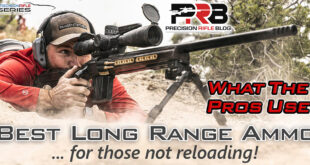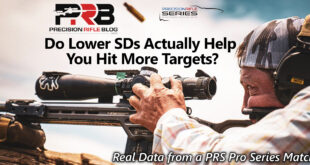One of my friends recently told me they sort bullets by both weight and length of their bearing surface (the part of the bullet that comes in contact with the barrel, illustrated below). I hadn’t thought of that before, but you could see how variations in the bearing surface length obviously impact the amount of barrel friction on the bullet and therefore cause variations in muzzle velocity.
For virtually all of my precision shooting I use Berger bullets, and I wondered if there was even any measurable variation in their bearing surface because their quality control is so much tighter than other bullet makers. So I measured the bearing surface on over 150 bullets, and here are the results I found.
Bullet: Berger 7mm 168gr Hunting VLD (Lot #4375, Purchased Oct 2012)
Standard Deviation: 0.00073″
There is a measurable difference … larger than I originally expected. You can decide whether this is significant or not. I know people who claim that it is, and although I am currently still sorting bullets by bearing length I’m not sure if it is statistically significant. Essentially I’ve found a standard deviation of 0.00073″, which is 0.1% of the bearing surface length. I wouldn’t think 1/10th of a percent could have enough of an effect on barrel friction to result in any measurable effect on muzzle velocity … but I can’t prove that, so the decision is up to you. I would expect bullets that weren’t match-grade may show higher variance in bearing surface length.
How To Measure True Bullet Bearing Surface Length
Some people measure bearing surface differently. A lot of people just measure from the bullet base to ogive, which is essentially the bearing surface if it is a flat base bullet. However, with boat tail bullets that isn’t the bearing surface. You actually have to attach two bullet comparators to a caliper so that it measures from the start of the bearing surface on the rear/bottom of the bullet, instead of the base of the bullet.
So here is the setup I use to measure bullet bearing surface length. It is essentially two Hornady Lock-N-Load Bullet Comparators of the same caliber attached to a caliper. You need to ensure they are precisely aligned for repeatable measurements.
 PrecisionRifleBlog.com A DATA-DRIVEN Approach to Precision Rifles, Optics & Gear
PrecisionRifleBlog.com A DATA-DRIVEN Approach to Precision Rifles, Optics & Gear









R U still doing this to Berger bullets ? Measure it with a 2×4, mark it with a grease pencil and cut it with an axe.
Now, about that wind reading video tutorial !
Ha! Funny you should ask. Obviously I’m having an epiphany moment with my “How Much Does It Matter?” series of posts. It’s a pretty major shift for me personally, which has taken some time and convincing … but I think I have a better handle now on the biggest reasons my bullets don’t connect with their intended target at long range … and it isn’t bullet bearing surface variation! It’s 99% wind calling ability. And I’m now 100% focused getting better at that these days. When I get it whipped, maybe I’ll come back to details like this … if I’m not in a nursing home by that point!
I will say I actually stopped doing this when I switched to my 6XC. At that point I started using Berger’s outstanding 105gr Hybrid bullets. At first, I sat down to sort them by weight and bearing surface, just like I’d been doing for years on my 7mm Rem Mag … but after that first exercise I noticed I really just had one pile of bullets in front of me. The consistency of those bullets was A LOT better than the Hunting VLD bullets I was used to, so I decided to just pull them out of the box and seat them. Maybe I got a good batch, but luckily I bought 5000 bullets from that batch! So it will be a while before I know. So, no … I don’t do any of this on my 6XC, and that’s what I’ve been shooting almost exclusively these days. Great cartridge and great rifle! Hard to reach for anything else when I open my safe door!
Thanks,
Cal